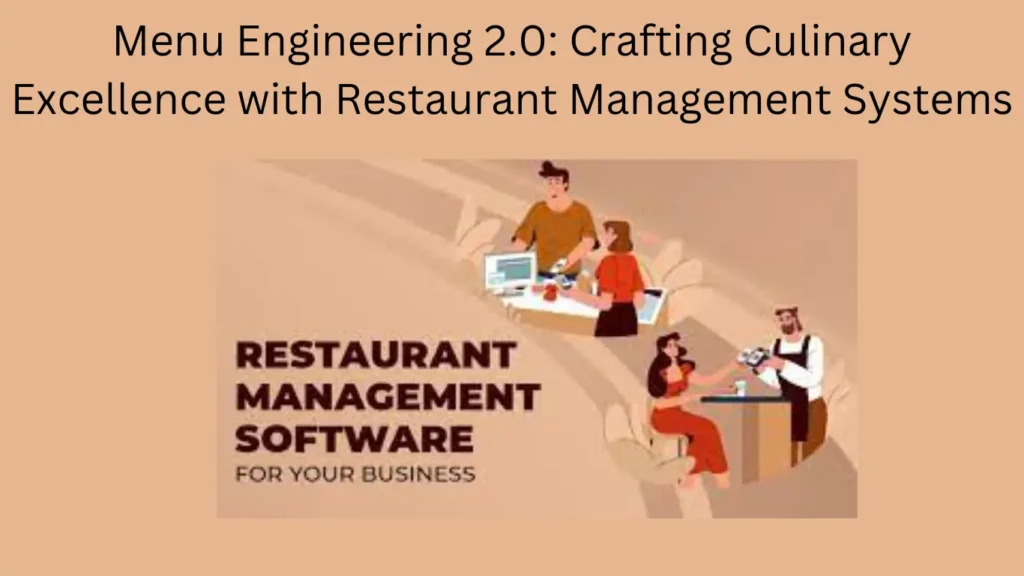In the ever-evolving culinary world, the concept of menu engineering has become a critical component for restaurant success. With the advent of advanced technology, particularly Restaurant Management Systems (RMS), menu engineering has reached new heights. RMS not only simplifies the creation and management of menus but also provides valuable insights that drive profitability and customer satisfaction. This guide explores how RMS can be leveraged to craft culinary excellence, ensuring your menu is both enticing and efficient.
1. Data-Driven Menu Design
Analyzing Sales Data
Restaurant Management Systems collect comprehensive sales data, allowing you to identify the best and worst-performing items. By understanding what sells well, you can tailor your menu to feature popular dishes and remove or improve less successful ones.
Customer Preferences and Trends
RMS tracks customer preferences and emerging trends, helping you to design a menu that appeals to your target audience. Whether it’s incorporating more plant-based options or seasonal specials, RMS provides the insights needed to stay relevant and appealing.
2. Optimizing Menu Layout
Simplifying Choices
An effective menu is easy to navigate. RMS can help analyze which sections or categories of your menu are most popular, allowing you to streamline choices and reduce complexity. This not only enhances the customer experience but also speeds up decision-making.
3. Cost Control and Pricing Strategy
Accurate Cost Analysis
With detailed ingredient tracking and cost analysis, RMS enables you to understand the exact cost of each dish. This transparency allows for precise pricing strategies that ensure profitability while remaining competitive.
Dynamic Pricing
RMS can support dynamic pricing models, adjusting prices based on demand, time of day, or seasonal factors. This flexibility can help maximize revenue and keep your pricing strategy agile.
4. Enhancing Culinary Creativity
Recipe Management
RMS provides a centralized platform for managing recipes, ensuring consistency in taste and presentation. This standardization is crucial for maintaining quality across all dishes and locations.
Experimentation and Feedback
With an RMS, you can easily introduce new dishes and gather immediate customer feedback. This real-time data helps in refining recipes and making informed decisions about which items to permanently add to the menu.
5. Streamlining Operations
Efficient Inventory Management
By integrating inventory management with menu planning, RMS ensures that you always have the necessary ingredients on hand. This reduces waste, prevents stockouts, and keeps your kitchen running smoothly.
6. Marketing and Promotions
Targeted Marketing Campaigns
Using data from RMS, you can create targeted marketing campaigns to promote specific menu items. Personalized offers and discounts based on customer preferences can drive traffic and boost sales.
Seasonal and Limited-Time Offers
RMS allows for easy implementation of seasonal or limited-time offers. These promotions can create a sense of urgency and excitement, encouraging customers to try new items.
Conclusion
Menu engineering is an art and science that, when paired with the power of Restaurant Management Systems, can transform your culinary offerings. By leveraging data-driven insights, optimizing menu layout, controlling costs, enhancing creativity, streamlining operations, and executing targeted marketing strategies, RMS can help craft a menu that delights customers and drives profitability.
Embrace Menu Engineering 2.0 with an RMS to ensure your restaurant remains competitive, innovative, and customer-focused. With the right tools and strategies, you can create a dining experience that stands out, ensuring culinary excellence and business success.
For further Inquires Contact Us
FAQs
What is menu engineering?
A: Menu engineering is the process of designing a menu to maximize profitability and customer satisfaction by analyzing sales data, customer preferences, and food costs to strategically highlight high-margin items.
How can a Restaurant Management System (RMS) help with menu engineering?
A: An RMS helps with menu engineering by providing data-driven insights into sales trends, customer preferences, and cost analysis, enabling restaurants to optimize their menu for profitability and customer appeal.
How does data from an RMS improve menu design?
A: Data from an RMS helps identify best-selling and underperforming items, track customer preferences, and analyze food costs, allowing for informed decisions on menu layout, pricing, and item placement.
Can an RMS assist with dynamic pricing?
A: Yes, an RMS can support dynamic pricing by adjusting prices based on factors such as demand, time of day, or seasonal trends, helping to maximize revenue and adapt to market conditions.
How does an RMS enhance inventory management for menu planning?
A: An RMS integrates inventory management with menu planning, ensuring that necessary ingredients are always in stock, reducing waste, preventing stockouts, and keeping the kitchen running efficiently.

